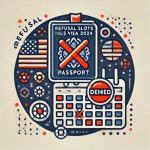As the academic environment keeps changing, more & more international students are looking for ways to study in the US. A vital entry point for these people is the F1 visa, a non-immigrant student visa that enables them to pursue their academic goals at recognized universities around the nation. Potential students are preparing to handle the challenges of the application process as F1 visa spots for the Fall 2024 semester become available.
Students from all over the world are vying for admission to American universities & colleges during this time, which is characterized by increased anticipation and preparation. Beyond just granting access to the United States, the F1 visa is significant because it can have a life-changing impact on a student’s future. The chance to interact with cutting-edge research, form a global network, and immerse oneself in a diverse academic environment is priceless. The process of acquiring an F1 visa is not without its difficulties, though, such as comprehending the application deadline, fulfilling particular prerequisites, and getting ready for interviews. Prospective students must be proactive and well-informed as we go into the specifics of the Fall 2024 F1 visa application process. admission to a recognized educational institution.
Being accepted into an accredited institution is usually the first step in the process, as it is a requirement for applying for an F1 visa. Students will receive a Form I-20 upon acceptance, which is a necessary document to start the visa application process. Students should apply as soon as possible to the schools of their choice, preferably by the end of 2023 or the beginning of 2024, to get enough time to collect the required paperwork and finish their applications. arranging interviews for visas.
Students should know when their visa interviews are scheduled after they have been accepted and received their Form I-20. The U. A.
Visa applications are typically opened by the Department of State several months prior to the start of the school year. Due to the high demand, students should try to set up their interviews for Fall 2024 by the middle of the year, as spots can fill up quickly. keeping abreast of changes to the policy. Also, since these can affect timelines and availability, it is essential to monitor any modifications to policies or procedures that may occur as a result of international events or changes in immigration laws.
Students can guarantee a successful F1 visa application process by being informed and making plans in advance. Meeting important deadlines is crucial to obtaining an F1 visa spot for Fall 2024. Students need to be careful to schedule their appointments for visa interviews as soon as they open up. The likelihood of obtaining a desired date and time can be greatly increased by taking early action, as these slots are usually released on a first-come, first-served basis.
Students are advised to check the U on a regular basis. S. check the website of the embassy or consulate in their nation of residence for information on available slots and any special booking instructions. Students must be aware of the due dates for submitting their documents and paying fees in addition to scheduling interview times. Prior to the visa interview, the Student and Exchange Visitor Information System (SEVIS) fee must be paid.
Students should also make sure that all necessary paperwork, including bank statements, academic transcripts, and evidence of ties to their nation of origin, is ready well in advance. It is crucial to plan ahead & be organized throughout this process because missing these deadlines can result in delays or even the rejection of the visa application. Although getting an F1 visa spot can be a competitive process, there are a few tactics prospective students can use to increase their chances of success. The most important thing is to keep up with the most recent news from the U.S. S.
information about visa regulations and procedures from the Department of State and regional embassies. This data may shed light on prospective modifications that could impact application requirements or slot availability. Also, participating in online discussion boards or social media communities devoted to international students can provide helpful advice and firsthand accounts from people who have recently gone through the process. Making all required documentation ready in advance is another smart move. This includes personal statements & recommendation letters, if needed by the institution, in addition to academic records and financial statements. When deadlines draw near, having these documents well-organized and easily accessible will expedite the application process and lessen anxiety.
Students should also think about contacting their selected universities for advice on any particular needs or suggestions they may have about the visa application procedure. One crucial step in the application process that has a big impact on how a student’s F1 visa application turns out is the interview. Consular officials evaluate applicants’ eligibility during this interview based on a number of criteria, such as their plans to pursue education, their financial security, & their ties to their nation of origin.
Students must approach this interview with self-assurance and a clear understanding of their American educational objectives. They can show their dedication and seriousness about their studies by explaining why they selected a specific program or institution. Knowing the typical questions that consular officials might ask is another important aspect of interview preparation.
These inquiries frequently center on the applicant’s financial situation, post-graduation goals, and study plans. Students should get comfortable answering questions succinctly & clearly while remaining upbeat during the interview. A successful outcome is further increased by making a good impression on consular officials by dressing professionally and being on time.
being aware of the requirements. Students must carefully go over every requirement listed by the U.S. government in order to successfully complete the F1 visa application and interview process.
A. embassy or consulate back home. This entails being aware of the required paperwork, including Form I-20, evidence of financial stability, passport validity, and any other forms that might be needed. assembling the documentation.
During this important stage, making a checklist can help guarantee that no important documents are missed. It is important for students to make sure they have a valid passport, proof of financial support, and Form I-20. Rehearsing interview skills. Students should spend time practicing interviewing skills in addition to obtaining documentation.
Practicing interviews with friends or relatives can yield insightful criticism & boost self-assurance when answering possible inquiries from consular officials. By researching common pitfalls, such as giving evasive answers or coming across as unprepared, applicants can steer clear of errors that could compromise their chances of being granted an F1 visa. Manifesting dedication. Finally, being well-prepared shows a sincere desire to study in the US and boosts confidence.
Students who put in the effort to prepare stand a better chance of getting an F1 visa and succeeding academically. In order to secure their F1 visa slots, prospective international students must continue to be proactive and watchful as Fall 2024 draws near. Students can successfully navigate the sometimes difficult & demanding process of going from application to interview with careful planning and preparation.
It’s critical to keep up with significant dates and due dates and to be flexible in the event that immigration laws or procedures change. In conclusion, prospective students should keep in mind that acquiring an F1 visa offers a chance for academic success and personal development in a different cultural setting, in addition to meeting formalities. Through a dedicated & enthusiastic approach to this process, students can set themselves up for success in achieving their educational goals in the United States. They should remember that every action they take today moves them one step closer to their goals for the future as they set out on this exciting journey.





